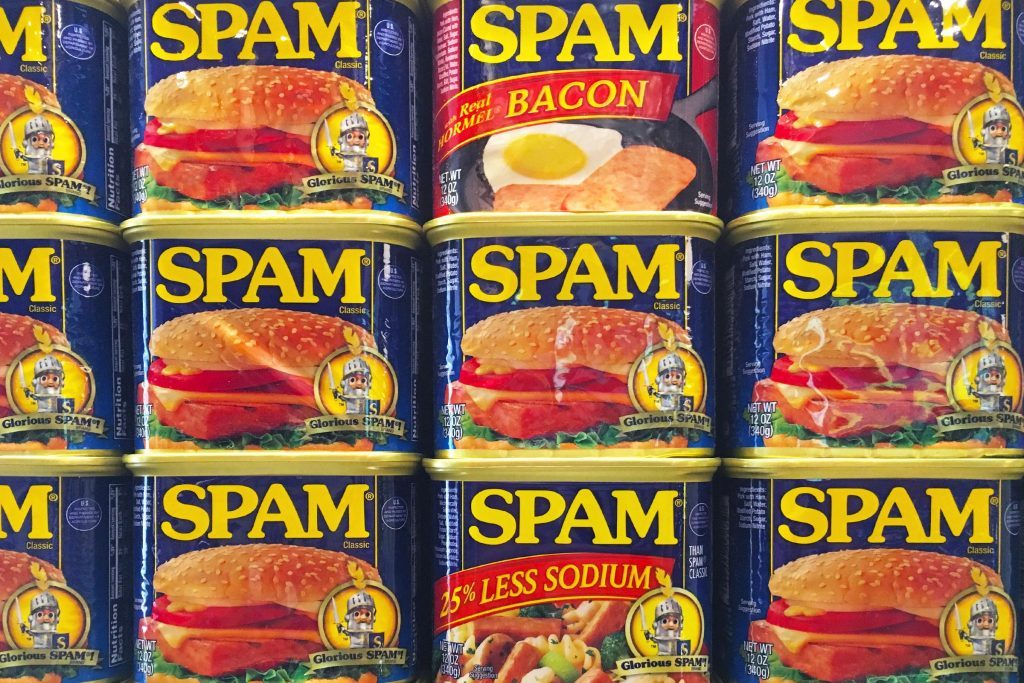

It's gained a bit of a reputation as a mystery meat, but its recipe is actually pretty simple!
It shares its name with those annoying emails you don't want. It comes in a can and is made of…some kind of meat? Whether you grew up eating it and still do or you've merely eyed it suspiciously in a supermarket aisle, you've probably found yourself wondering "What is SPAM?" at some point. Now that this mysterious grocery item is becoming popular again (a Utah-based grocery chain saw SPAM sales jump as shelter-at-home orders came into place), we went ahead and found out what it really is for you. Did you know that SPAM has been around for much longer than you think?
What is SPAM?
SPAM is a canned lunch meat product that first hit shelves in 1937. It was created in Austin, Minnesota by the manufacturers Hormel Foods. Toward the end of the Great Depression, SPAM helped fill a huge need for inexpensive meat products. And its popularity only grew. "It cemented its place in the culinary world during World War II, due to its ability to be stored for long periods of time," explains James Schend, food editor at Taste of Home. "It could be easily shipped around the world." And it was, both then and now; today SPAM products are available in 44 different countries, according to their brand site.
Today, there are 15 different SPAM varieties, from Classic to Teriyaki to Jalapeño. Love it or hate it, you can't deny that it's everywhere. Over eight billion SPAM products have been sold worldwide, and in 2016, a SPAM museum opened in its birthplace, Austin, Minnesota. Learn about the surprising birthplaces and origins of 19 more foods you see everywhere.
What is SPAM made of?
It may come as a pleasant surprise to learn that SPAM is not the preservative-packed mystery meat you might think it is. In fact, SPAM only contains six ingredients! And the brand's website lists them all. They are: pork with ham meat added (that counts as one), salt, water, potato starch, sugar, and sodium nitrite. Most of those are as simple as simple gets. The only one that might raise eyebrows a little is the sodium nitrite, which is "a preservative to help retain freshness," Schend explains. The website says that it is there to "uphold the meat's high standard of quality."
To make SPAM, the ground-up pork and ham are mixed with the other ingredients for 20 minutes. When the mixture reaches the proper temperature, it's put into the cans, which are vacuum-sealed. The cans are cooked and then cooled for three hours, after which they're ready for their labels. And that's all there is to it.
What does SPAM stand for?
While SPAM's ingredients are pretty straightforward, its name is actually less so. In 1937, Hormel held a competition to name the new product. The winning choice, SPAM, was suggested by Ken Daigneau, whose brother was a vice president at Hormel. He won a cash prize of $100 for choosing the name. So it seems like this naming competition may have been something of an inside job.
As for why he chose "SPAM," and what it means? Unfortunately, we can only guess! Although it appears in all capitals on all official product materials, nowhere on the site does it say that SPAM is an acronym for anything. Sure enough, "What does the SPAM brand name mean" is one of the Frequently Asked Questions on the brand's website, but their answer is vague at best. "The significance of the SPAM® brand name has long been a subject of speculation," the page says. "The real answer is known by only a small circle of former Hormel Foods executives." So they're keeping the mystery alive.
One of the most popular suggestions is that it's an abbreviated version of "shoulder of pork and ham." According to Schend, "Many believe it is short for 'spiced ham,' but…since the only 'spice' ingredient in it is salt, I think there is a different reason for the name." If you find that answer a bit unsatisfying, you'll be happy to know that these 16 iconic foods have much better stories behind their names.
But hey, if there's going to be a mystery surrounding "what is SPAM," we'd rather have it be the meaning of its name than what it's made of. Next, every foodie should know these 20 facts about food that might change the way you eat.
Popular Videos
What Is SPAM, Anyway?, Source:https://www.rd.com/food/fun/what-is-spam/